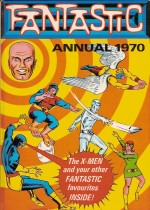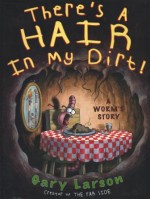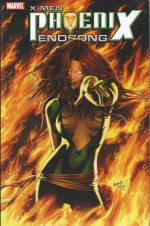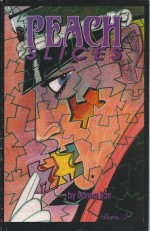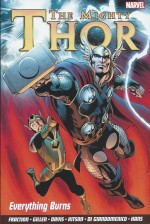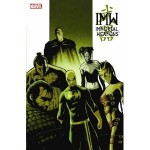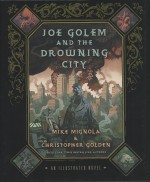Since the Mayans miscalculated and we’re all (most?) still here, I’ve gotten all extra-nostalgic and doubled my pleasure by indulging in not just one but two days of British Annual excellence…
Today’s Cool Yule Drool comprises a trio of my most often enjoyed festive frolics and tomorrow we’re doing it again with even more passion but just a little less imaginatively.
Have a Very Merry Day and always keep reading new things…
Robin Annual Number 1
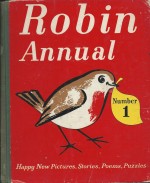
By various, edited by Marcus Morris (Hulton Press)
No ISBN:
There’s not a lot around these days in our field which both caters specifically for little kids and simultaneously introduces them to the ineluctably tactile wonders and sensorium of a high quality comics anthology experience, but once upon a time there was a whole subdivision of the business dedicated to enthralling and enchanting our youngest and, hopefully, brightest…
Robin was created in the hugely successful wake of Marcus Morris and Frank Hampson’s iconic Eagle, catering to the pre-school market the way Swift targeted 6-10 year olds and Girl concentrated on potential young ladies (that looks far creepier in print than I’d intended…). The periodical ran from March 28th 1953 to 25th January 1969, a startling 836 joy-stuffed issues.
Offering a range of beautiful genteel, diffidently Christiano-centric stories, strips and puzzles for parents to read with and to their toddlers, Robin sported the same supremely high production values as all the Hulton Press titles. It was edited by Morris until 1962 when Clifford Makins took over, shepherding the title until its absorption into Odhams/Fleetway comic Playhour, just as the collapse of theUK comics industry was beginning…
There were at least nine Christmas Annuals – such as this first one from 1953 – which combined stunning, lavishly illustrated colour strips and features with solid, memorably stylish and glossy monochrome pages for an 80 page compendium of enticing wonderment between sturdily thick and reassuring red cardboard covers.
Again like its older brothers and sister, Robin included a selection of licensed characters well known to the new but ever-growing television audience…
This particular British Festive icon opens with double-page front and end-pieces by Reg Forster, depicting railway station scenes to colour in and a beautiful painted dedication to the young Princess Anne and Prince Charles, after which the prose tale of ‘Johnny and Mr Spink’ related the tale of a boy given a pony for his birthday.
The first comic strip is in colour. ‘The Amazing Adventure of Percy and the Cricket Ball’ featured anthropomorphic animals and a young man who turned sporting disaster to his advantage, followed by an illustrated poem ‘Things to Do’ and ‘The Story of Woppit’, a monochrome strip featuring an infamous teddy-bear in the snow with bunnies.
More shrew than bear, Mr. Woppit was merchandised as a toy and one was adopted as a lucky mascot by notoriously superstitious sportsman and speed enthusiast Donald Campbell. It was with him when Campbell died piloting the hydroplane Bluebird K7 on Coniston Water in 1967, and found amidst the floating wreckage.Campbell’s remains weren’t recovered until 2001.
A Play Page of puzzles is followed by the first TV star as ‘Andy Pandy’ played garden pranks on Teddy after which ‘The Old Woman and the Mouse’ offered a delightfully salutary prose fable illustrated by the incredibly talented David Walsh and then ‘The Twins Simon and Sally’ got into a mess feeding the chickens in their first strip saga.
‘Princess Tai-Lu’ was a magical Siamese cat and in her initial strip here celebrates Christmas with a few furry feline friends in her own unique manner, whilst the illustrated poem ‘Little Grey Stone’ by Margaret Milnes is a visual feast of tone-&-wash mastery and colour comic ‘Tom the Tractor’ related the heroic rescue of a climbing lamb and piglet by a handy animated farm vehicle,
‘Scruffy the Scarecrow’ was almost junked by the farmer until some friendly Magpies saved his job in a rather moving text tale, but ‘The Proud Mouse’ was the architect of her own downfall in a delightfully executed strip by an uncredited hand.
‘Richard Lion’ (and his animal chums Henry the kangaroo, Pug the bulldog, Peggy the black panther, Nemo the jester and others) seems like a rather excellent knock-off of Bestall’s Rupert Bear by the brilliant Maria Jocz, but it still offers wonder and joy aplenty in a two-chapter, vividly coloured strip which finds the cubs being harassed by and then saving some irascible Snow Gnomes. Next comes the second of the BBC’s Watch With Mother properties as Bill and Ben ‘The Flower-Pot Men’ saved a tortoise from his own exuberant folly in a captivating black and white strip.
A black Scottie dog narrates ‘The Sad Story of McTavish’ (by Norman Satchell) whilst ‘Charlie and the Cake’ takes only three panels to explain the folly of stealing confectionery from the larder…
The snow-bound adventures of Rufus, Rodney Rita and little brother “Fums†resulted in a new family pet thanks to the intervention of ‘The Magic Wellingtons’ in a beguiling colour strip, whilst, following a Bo Peep maze-page, ‘The Twins Simon and Sally’ return no wiser than before as their attempts to bath both a dog and cat at the same time goes spectacularly awry…
‘Midge the Motor Car’ was a living autonomous little auto and his trip to the local Fair resulted in initially chaos but eventually a dramatic and heroic rescue in a lovely monochrome strip from Catherine Hammond and an uncredited scripter, after which ‘The Shepherd Boy’ retold the story of David and Goliath in a stylish full colour comics version, and short story ‘The Runaway Bus’ – illustrated by Forster – detailed how a London Passenger Service Vehicle took itself off to the seaside for the day…
The poem ‘Eider Downy House’ (Gay Wood) is followed by the sublime black and white nature strip ‘The Dormouse at Christmas’ and a full colour rebus double spread of the alphabet before the prose tale of ‘Ku Mu and the Crocodile’ (written and illustrated by Dorothy Craigie) told a gentle tale of West Africa and the strip ‘Bingo, Bango and Bongo’ by Jenetta Vise demonstrated to three monkeys that performing in a circus was far more fun than merely spectating…
A ‘Mrs Bunny Maze Puzzle’ precedes the all-colour adventures of talking calf ‘Johnny Bull’ on land, sea and in the air, after which the superbly limned prose story ‘The Excited Red Balloon’ shows the sheer class of illustrator Eileen Bradpiece, before Technicolor tiny titan ‘Andy Pandy’ performed a prankish encore at a tea-party for Teddy and ‘Tina, Tim and the Magic Helicopter’ undertook an astounding prose voyage to the Wild West…
Patricia Hubbard drew an amazing strip adventure of the dolls in ‘Toyville’ and, following the conclusion of Richard Lion‘s excursion to the cave of the Snow Gnomes and another rebus page entitled ‘Can You Read this Letter?’, ‘The Flower-Pot Men’ accidentally built themselves a splendid flying sailboat.
The rather trenchant warnings in the tale of ‘Canty Kitten’ are balanced by a practical feature on ‘How to Draw a Toy Engine’, after which David Walsh displays his dexterity with both monochrome and full colour scenes for the ode to ‘Skating on a Pond’ and the enigmatic Kearon (perhaps Robot Archie artist Ted Kearon?) exhibits great virtuosity in relating the strip saga of ‘Philip’s Circus’…
The indefatigable Walsh then lent his deft pen and brush to the alarmist but happily ended text tale of ‘The Squirrel Who Forgot’ and sublime ‘Princess Tai-Lu’ returned to save her human companion’s hat in another lovely monochrome strip.
‘Billyphant’s Birthday’ provided a menagerie of pets for the lonely little pachyderm and that motivated Motor Car returned in ‘Midge at the Zoo’, handling runaway rhinos and adoring peacocks alike, before another Play Page segued into a black and white bible strip detailing what happened when ‘Jesus gets lost’ and all the seasonal magic ended with the prose saga of runaway pigs ‘Quibble and Quarrel’.
Unlike most periodicals of the time, this annual actually lists all the creative contributors involved – although not which pieces they worked on – so those I’ve been unable to identify I’ve name-checked here: writers Leila Berg, Maria Bird, John Byrne, Nancy Catford, Dennis Duckworth, Jessica Dunning, Rosemary Garland, James Hemming, Maureen Hillyer, Winifred Holmes, Ursula John, Rosemary Sisson, John Taylor, Billy Thatcher, & Shelagh Fraser whilst artists unattributed include Anthony Beaurepaire, Nancy Catford, Harry Hants, Irene Hawkins, Elizabeth Hobson, Stewart Irwin, Faith Jacques, Janet & Anne Graham Johnstone, Mary McGowan, Constance Marshall, Michael K. Noble, Walter Pannett, Prudence Seward, A.E. Speer, Astrid Walford & Andrew Wilson.
Relatively cheap and still quite available, books like this were and should remain an integral part of our communal history, always astoundingly high in quality and absolutely absorbing. Whimsical, comforting and supremely entertaining, this is a package with a host of child-friendly tales that have tragically missed becoming nursery classics simply because they appeared in a disposable comic rather than permanent kid’s novel, and it’s long past time publishers re-examined this wealth of forgotten material with a view to creating new masterpieces for library shelves and wholesome all-ages TV animation projects…
No copyright notice so I’m guessing most of the originally created intellectually properties material now resides as part of IPC or Egmont. If you know better I’ll be happy to have this entry amended.
Superadventure Annual 1967

By various (Atlas Publishing & Distribution)
No ISBN
Whereas the 1962 edition – the first Christmas Annual I can remember getting – was a stunning shock to my British-born, Polish/German reared, pre-school senses, by the advent of the 1967 Superadventure Annual (December 25th 1966 at about 11 minutes past 4 in the morning), I was a far more sophisticated but no less excitable consumer.
I had since learned in those short intervening years quite a bit about Superman, Jimmy Olsen, Aquaman, Green Arrow, Flash, Tommy Tomorrow and all the rest through the sleek American import comics that my Dad faithfully brought home every Friday after work, teaching me – and himself – English (admittedly American-seasoned) by poring through them together over weekends filled with sugary snacks and in-between huge, rustic, home-grown and Mum-cooked meals.
That early indoctrination and fascination remains strong – for the comics at least. I’m far too old and debilitated for sugar, starch, caffeine and artificial additives now…
This was one of the last licensed UK DC collections before the Batman TV show turned the entire planet Camp-Crazed and Batmanic, and therefore offered a delightfully eclectic mix of material far more in keeping with traditionally perceived British boy’s interests than the masked suited and booted madness that was soon to follow in the Caped Crusader’s scalloped wake. Of course this collection was still produced in the cheap and quirky mix of black and white, dual-hued and full colour pages which made those Christmas books such a bizarrely beloved treat.
The action opens with a classically lovely yarn starring the Fastest Man Alive, printed in black and red.
The first story is reprinted from The Flash #119 (March 1961), crafted by John Broome, Carmine Infantino & Murphy Anderson, and related how the lethal Looking Glass Bandit used his incredible technology to turn our hero into a living genie before attempting to murder him with ‘The Mirror Master’s Magic Bullet’ after which space cop Tommy Tomorrow tackled – in plain old monochrome – ‘The Planeteer’s Alien Allies’.
The strip was a hugely long-running back-up strip which moved from Real Fact Comics, to Action Comics and Worlds Finest Comics before fading from sight and memory. This particular tale of sneaky conniving ETs only pretending to be Earth’s friends comes from WF #122, December 1961, courtesy of scripter Jack Miller and versatile illustrator Murphy Anderson. Ubiquitous gag cartoonist Henry Boltinoff produced hundreds of funny pages and characters over the years, and a great selection are sprinkled through this book, beginning with a crafty ‘Casey the Cop’ howler…
World’s Finest Comics #125 from May 1962 provided the Green Arrow thriller ‘The Man Who Defied Death’ (by Ed “France†Herron and Lee Elias); a bold and grittily terse mini-epic and taut human drama about a desperate daredevil willing to do absolutely anything to earn the cash for his son’s medical bills, followed by a Boltinoff ‘Moolah the Mystic’ rib-tickler and the start of the full (but exceedingly odd) colour section.
Superman’s Pal Jimmy Olsen #60 (April 1962) provided the astonishing story of ‘Super-Mite’ as author Leo Dorfman & artist Al Plastino had the exuberant cub reporter explore the mystery of a little action figure given by the Man of Steel to an ailing boy which inexplicably became as smart and powerful as any full-sized Kryptonian! This is followed by a Boltinoff gag starring ‘Peter Puptent, Explorer’ and a chiller featuring Aquaman and Aqualad battling ‘The Curse of the Sea Hermit’.
First seen in Detective Comics #295, September 1961 by George Kashdan & Nick Cardy, this spooky sea tale seemingly pitted the heroes against ancient evil but there was ultra-modern piratical plundering behind this scheme…
Back in black and white, ‘The Trickster Strikes Back’ (Flash #121, June 1961) saw the rapacious return of an air-walking bandit with murderous intent, outmanoeuvred by the Vizier of Velocity in a stunning yarn from Broome, Infantino and Joe Giella whilst, after another Peter Puptent page, Tommy Tomorrow undertook a desperate ‘Journey to 1966’ (originally entitled ‘Journey to 1960’, by Miller & Jim Mooney, when it first appeared in WF #113, November 1960) to capture a would-be world-conqueror with the inadvertent aid of the Planeteer’s own grandfather, after which the grand Costumed Dramas end in fine style with ‘The League of Fantastic Supermen’ (by Jerry Siegel, Curt Swan & George Klein from Superman’s Pal Jimmy Olsen #63, September 1962) in which a quartet of Kryptonian outlaws and the double-dealing Legion of Super-Villains are all outwitted by the plucky junior journalist.
Maybe I’m blinded by nostalgia-coloured goggles, but it seems admirably astounding to me that the all-ages stories featured here are so perfectly constructed that whether an innocent(ish) tubby toddler or the sullen, embittered old coot I became, these tales continue to beguile, bemuse and satisfy in a way that no food, drink or drug could. This is another book that will always say “Merry Christmas†to me.
…And hopefully to you, too…
© 1966 National Periodical Publications, Inc.,New York. Published and distributed jointly by Atlas Publishing and Thorpe & Porter, Ltd., by arrangement with The K.G. Murray Publishing Company Pty. Ltd., Sydney.
Beano Book 1972
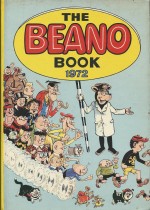
By various (DC Thomson & Co., Ltd.)
Retroactively awarded ISBN: 978-0-85116-038-2
For many British – and indeed Commonwealth – fans, Christmas can only mean The Beano Book (although Scots worldwide and of every nationality have a pretty fair claim that the season belongs exclusively to them via the traditional, annually-alternating collections of The Broons and Oor Wullie which make every December 25th mirthfully magical), so I’ve yet again highlighted another of the venerable and beloved tomes as particularly representative of the Season of Joy.
In those days these annuals were produced in the wonderful “half-colour†British publishers used to keep costs down. This was done by printing sections or “Signatures†of the books with only two plates, such as Cyan (Blue) and Magenta (Red): The sheer versatility and colour range this provided was astounding. Even now this technique inescapably screams “Holidayextras†for me and my contemporaries.
As is always the tragic case, my knowledge of the creators involved is criminally sub-par but I’ll hazard the usual wild guesses in the hope that someone with better knowledge will correct me when I err and embarrassingly get it wrong again…
This boisterously compelling chronicle opens with a double-page splash of The Bash Street Kids (by David Sutherland) breaking the fourth wall and playing mischievous hob with the book’s two-colour formatting, after which The Three Bears by Bob McGrath and the exceedingly domestic Biffo the Bear (Sutherland again) officially welcome us to the festivities.
Leading off this year’s anarchic antics is a splendid school Panto skit starring Minnie the Minx courtesy of Jim Petrie, after which the iconoclastic Dennis the Menace and Gnasher make their first appearance adding their own unique tinge of terror to a school play thanks to prolific diversity of style chameleon David Sutherland.
“Fastest boy on Earth†Billy Whizz (by Malcolm Judge) then experiences painful feedback from a rashly hurled boomerang and his Antipodean counterpart, before the re-assembled Bash Street Kids helpfully assist Teacher get over his over-sleeping problem with the expected catastrophic results in a dedicated and extended niche chapter interwoven with the eccentric and imaginative ‘Bash Street Motor Cartie Show’.
Biffo and human pal Buster go shopping for new furniture next – in an eye-popping blue and yellow segment – after which Roger the Dodger is again outwitted by his dad and Lord Snooty learns the error of his selfish, posh-boy ways in a brace of gloriously funny strips from Robert Nixon, whilst Ronald Spencer’s painfully un-PC but exceedingly hilarious Little Plum follows with the rambunctious redskin falling foul of a bolshie buffalo before Billy Whizz rockets back with a tricky ‘Whizz Quiz’ to test our wits and reactions.
In a previous annual the Bash Street Kids found themselves the reluctant owners of an accident-prone elephant, and she riotously returns here in an extended episode of Pups Parade starring the Bash Street Dogs (and Ethel Hump) by the marvellous Gordon Bell. Stuck with the excitable, ponderous pachyderm by the awesome and omnipotent Beano Editor, the mangy mutts soon handed her off to their arch-foes The Bash Street Cats but it took the canny connivings of ‘The Nibblers’ (drawn by either John Sherwood or Ron Spencer?) to finally quell Ethel’s destructively effusive spirits…
At this time The Beano still had the odd adventure strip and perhaps the greatest of these was local boy superhero Billy the Cat. Here in an expansive section of his own, the plucky acrobat chases burglars over rooftops, crushes bullies, catches car thieves and almost mucks up a fire drill in a rollicking rollercoaster of blistering action by Sandy Calder – and there’s also a splendid ‘Quick on the Draw’ feature inviting readers to become artists themselves…
Biffo the Bear then endures an agony of indecision whilst his hirsute and voracious American cousins The Three Bears got a slap-up Christmas feed even after failing again to breach the impregnable local general store of grocer Hank Huckleberry…
The defences of Bunkerton Castle proved too much when Lord Snooty and His Pals tried to bring in a truly tremendous Xmas tree, but Minnie the Minx had far more success in her spring-heeled hi-jinx – until Dad caught her, at least – whilst the ‘Billy Whizz Diary’ proved its worth in mirth before Little Plum and that buffalo had their hands and hooves full trying to wigwam-train Chiefy‘s latest pet – a Smart Alec chimpanzee…
The Nibblers next resumed their war of attrition with malicious moggy Whiskers whilst Roger’s latest Dodges proved ultimately unsuccessful but did prompt him to dream big and explain what would happen ‘If I Were a Rich Boy…’
Another extended journey to Bash Street found the Kids literally sucking up to Teacher after “borrowing†a Corporation Dust Cart and industrial vacuum cleaner, whilst following some enthralling, appalling ‘Party Puzzles’ the ‘Pup Parade’ ended the segment with a dirty scheme to clean up the dog’s communal dustbin home…
Biffo then worked out with the local Fire Brigade and ‘The Three Bears’ had snow fun at all when Hank trapped them with a frigid, foodless maze, after which Minnie found things to amuse herself – but not so many other folks – building snowmen…
The Festive fun then concludes with a thinly veiled but entertaining ad for that year’s Dennis the Menace Annual and a return to the Bash Street Kids’ colour cavortings…
This is another astoundingly compelling edition, and even in the absence of legendary creators such as Dudley Watkins, Leo Baxendale and Ken Reid there’s no discernable decline in the outrageous and infectious insanity. With so much merriment on offer I can’t believe this forty year old book is still sprightlier and more entertaining than most of my surviving friends and relatives. If ever anything needed to be issued as commemorative collections it’s these fabulous DC Thomson annuals…
Divorcing the sheer quality of this brilliant book from nostalgia may be a healthy exercise – perhaps impossible, but I’m perfectly happy to simply wallow in the magical emotions this annual still stirs. It’s a fabulous laugh-and-thrill-packed read from a magical time, and turning those stiffened two-colour pages is always an unmatchable Christmas experience – and still relatively easy to find these days.
© 1971 DC Thomson & Co., Ltd.




